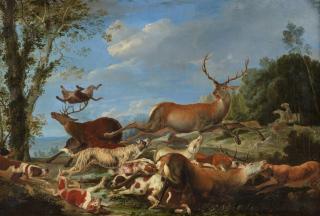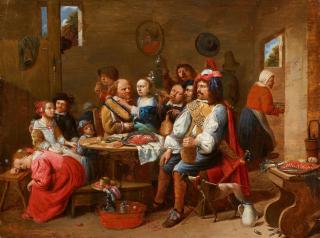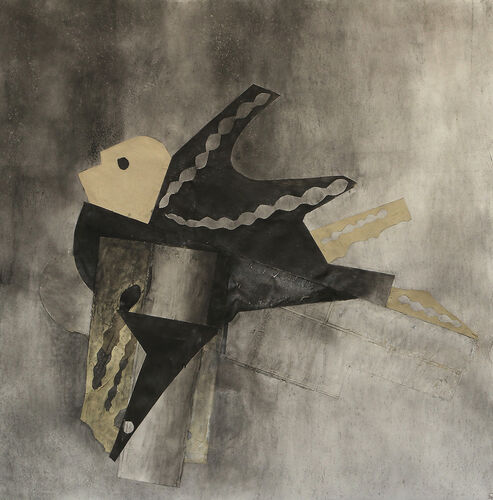Henry de Groux
Senta - aus Richard Wagners "Der Fliegende Holländer"
Found at
Lempertz,
Cologne
The Exceptional Bernard De Leye Collection, Lot 256
15. Jul - 15. Jul 2021
The Exceptional Bernard De Leye Collection, Lot 256
15. Jul - 15. Jul 2021
Estimate: 35.000 - 40.000 EUR
Price realised: 46.250 EUR
Price realised: 46.250 EUR
Description
Pastellkreiden auf Papier. 285 x 147 cm.
Unter Glas gerahmt..
Signiert unten rechts: Henry de Groux.
An opulent pastel, this "drawing" by Henry de Groux is an exemplary work of Belgian Symbolism, both in form and content. The artists of this epoch attached great importance to a refined, elaborate technique and a complex composition - perhaps even in deliberate contrast to the rapidly executed plain-air paintings of the Impressionists. At the same time, this work is an incunabulum of Symbolism in terms of its content and the message it conveys. Not only for de Groux, but especially for him, Richard Wagner's stage dramas and the pathos of his mystical figures with their dark dreams of death and redemption, were an important source of inspiration.
This monumental and detailed drawing refers to Wagner's opera "The Flying Dutchman". The female figure in the painting is Senta, whose self-imposed destiny was to redeem the doomed Dutchman. He was only allowed a short stay on land every seven years. If he found a woman who would remain faithful to him, he and his crew would be released from this spell. After their first encounter, Senta dreams and feels she has to redeem the damned, but the story does not end well. The Dutchman doubts Senta's faith and climbs aboard his ship. Senta calls after him "Treu bis zum Tod (Faithful to the death)" and throws herself into the sea. Instantly, the Dutchman's ship sinks and is redeemed. In a later correction of the finale, the Dutchman and Senta are seen rising from the sea to heaven to the "Erlösungsmotiv“, or the "theme of redemption".
Aus der Sammlung von SKH Prince Charles de Belgique.
Unter Glas gerahmt..
Signiert unten rechts: Henry de Groux.
An opulent pastel, this "drawing" by Henry de Groux is an exemplary work of Belgian Symbolism, both in form and content. The artists of this epoch attached great importance to a refined, elaborate technique and a complex composition - perhaps even in deliberate contrast to the rapidly executed plain-air paintings of the Impressionists. At the same time, this work is an incunabulum of Symbolism in terms of its content and the message it conveys. Not only for de Groux, but especially for him, Richard Wagner's stage dramas and the pathos of his mystical figures with their dark dreams of death and redemption, were an important source of inspiration.
This monumental and detailed drawing refers to Wagner's opera "The Flying Dutchman". The female figure in the painting is Senta, whose self-imposed destiny was to redeem the doomed Dutchman. He was only allowed a short stay on land every seven years. If he found a woman who would remain faithful to him, he and his crew would be released from this spell. After their first encounter, Senta dreams and feels she has to redeem the damned, but the story does not end well. The Dutchman doubts Senta's faith and climbs aboard his ship. Senta calls after him "Treu bis zum Tod (Faithful to the death)" and throws herself into the sea. Instantly, the Dutchman's ship sinks and is redeemed. In a later correction of the finale, the Dutchman and Senta are seen rising from the sea to heaven to the "Erlösungsmotiv“, or the "theme of redemption".
Aus der Sammlung von SKH Prince Charles de Belgique.
A top price for Henry de Groux
In July 2021 Lempertz in Cologne held the auction The Exceptional Bernard De Leye Collection, which included the work Senta - aus Richard Wagners "Der Fliegende Holländer" by Henry de Groux. The »bidding war« ended at EUR 46,250.00 16% above the upper estimate. With this result, Senta - aus Richard Wagners "Der Fliegende Holländer" is even the most expensive work of art by Henry de Groux that we have observed at auctions so far.
Ein Spitzenpreis für Henry de Groux
Im Juli 2021 führte Lempertz in Köln die Auktion The Exceptional Bernard De Leye Collection durch, in der auch die Arbeit Senta - aus Richard Wagners "Der Fliegende Holländer" von Henry de Groux zur Versteigerung kam. Das »Bietergefecht« endete beim Preis von EUR 46.250,00 und damit 16% über dem oberen Schätzpreis. Mit diesem Ergebnis ist Senta - aus Richard Wagners "Der Fliegende Holländer" sogar das teuerste Kunstwerk von Henry de Groux, das wir bisher bei Auktionen beobachtet haben.






































